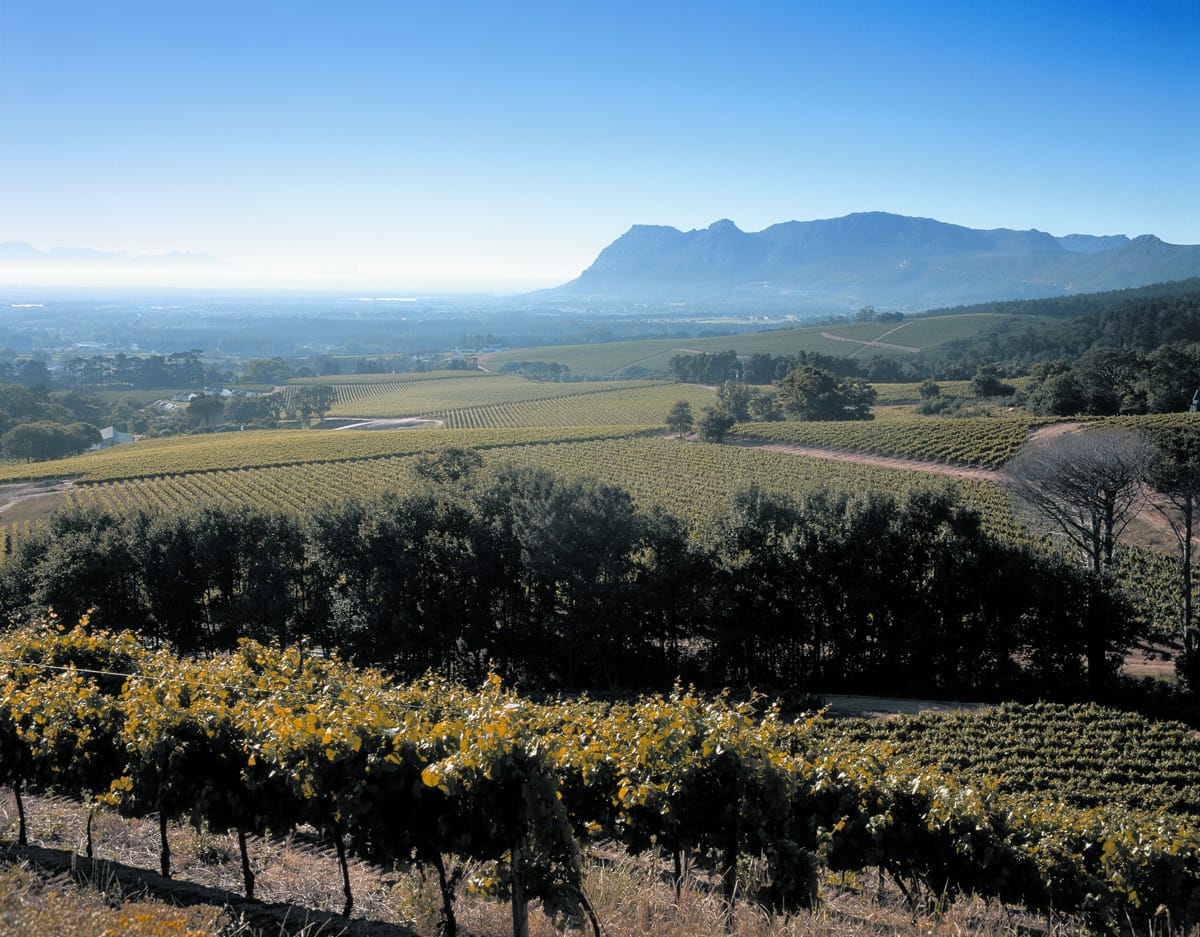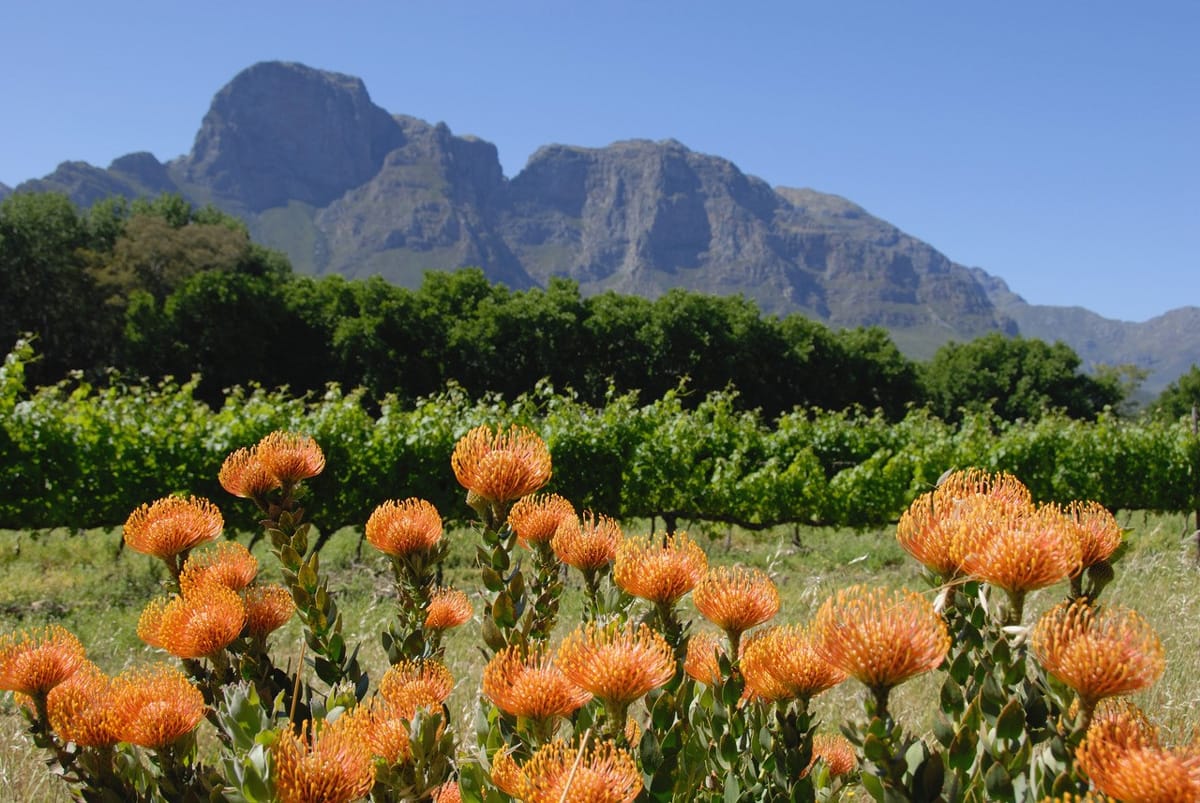
Wine Culture Magazine

Vineyards and mountain around Constantia. Henrik Holler photo, courtesy of WOSA.
Some places speak to your soul; they render you speechless and remain with you long after you have left.
The Cape Winelands of South Africa are that kind of place.
From Cape Town’s Table Mountain and lush neighbouring Constantia, its horn dipping sharply into the south Atlantic towards Antarctica, east to Walker Bay and Cape Agulhas, then northwest to the expanses of Swartland, this slice of the world is breathtaking.
The landscape here is timeworn, etched by immeasurable millennia. It was already ancient by the time the first vines were planted on the Cape over 360 years ago.
The landscape here is timeworn, etched by immeasurable millennia.
What brought them there was the Dutch East India Company.
In 1652, the Cape became a refueling and refreshment station for ships journeying from Europe to Asia. Those ships also delivered settlers and vines: South Africa’s first wine made its appearance in 1659, from vines planted by the first governor of the Cape, Jan van Riebeek, in 1655.
Twenty years later, wine enthusiastic Simon van der Stel succeeded van Riebeek, and with his expanded viticultural know-how, planted a vineyard on his farm in Constantia in 1679. However, it was when the Huguenot religious refugees arrived from France in the late 1600s that wine production truly advanced.
Throughout the following centuries, the industry saw growth and devastation, but it was not until after the end of apartheid, a system of institutionalised racial segregation from 1948 until the early 1990s, that the industry began to boom and the world slowly took notice.

Creation Vineyards in South Africa’s Hemel-en-Aarde Valley. Photo courtesy of WOSA.
The Stellenbosch region is widely known (due to its established wine reputation, university campus and quaint touristic appeal), but there is so much more to the Cape Winelands. Neighbouring coastal region districts such as Paarl, Franschhoek Valley and Cape Town, which includes Constantia, lure hordes of South African and international visitors to experience an admirably well-oiled wine tourism machine.
These entrenched districts might be the heart of wine on the Cape, but they are no longer its only draw.
In the past decade, Swartland has gone from a grain-producing region to one revered by a new wave of winemakers reaching outside the box of traditional winegrowing areas. Swartlanders launched a revolution that has since spread far and wide, pushing the boundaries of where vines are being planted. French and Portuguese varieties such as Cinsault, Tinta Barocca and Touriga Nacional are being embraced in Swartland, along with more traditional Shiraz and, of course, South Africa’s darling, Chenin Blanc.
While it’s been garnering accolades for cool-climate Pinot Noirs and Chardonnays for more than a decade, Walker Bay district’s Hemel-en-Aarde Valley has been invigorated in recent years. The town of Hermanus, where the southern right whales frolic close to shore, anchors Walker Bay, a small Cape South Coast district 120 kilometres east of Cape Town. The area is an absolute must-visit when in South Africa.
Flanking Walker Bay, Elgin to the west and Elim to the southeast are recognized for their suitability for grapes that prefer cooler temperatures, such as Sauvignon Blanc, Chardonnay and Pinot Noir. Elim’s Cape Agulhas is the most southerly tip of the continent and where the two great oceans, the Atlantic and Indian, collide; it is also the newest and most refreshing wine-growing climate on the Cape.
More wine-growing areas spread out across the Western Cape from Cape Town: Oliphants River (home to Citrusdal); Breede River Valley (home to Robertson); and Klein Karoo, among other smaller wards.

A vineyard behind the shrubland known as “fynbos.” Photo courtesy of WOSA.
While each region has its own charm, and succeeds with different varieties, there is no doubt what South Africa is currently known for: Chenin Blanc, Cabernet Sauvignon, Sauvignon Blanc and Shiraz. These make up the majority of what we drink here in British Columbia. And while we’re appreciative of the meager price tag on a significant portion of South Africa’s wine, don’t stop there—even the most premium wines from the Cape offer significant value and should not be overlooked.
World-class red and white wines with significant aging potential come from all its regions. A new generation of winemakers is forging a new path, seeking grapes from pockets of gnarly old vines and making wines with a sense of place, some in a hands-off or natural way. Obscure varieties from less traditional regions are becoming more commonplace, too.
It is a provocative time for South Africa’s wine industry, and one you’ll want to indulge in. Whether you book a flight to explore the Winelands or just pop the top on a great bottle at home, you’ll be drinking in the Cape—its culture, history and truly outstanding wines.
Six wines to try without boarding a plane.
Badenhorst Family Wines Secateurs Chenin Blanc 2017
(Swartland, $26) Sophisticated, weighty, complex.
Bellingham The Bernard Series Old Vine Chenin Blanc
(Coastal Region, $25) Concentrated, creamy, lively yet poised.
Boutinot Cinsault Sea & Air Cinsault 2017
(Coastal Region, $15) Juicy and charming red, berries, spice.
Riebeek Cellars Shiraz 2017
(Swartland, $13) Supple, spiced plums, licorice.
Glen Carlou Chardonnay 2016
(Paarl, $24) Creamy, fresh, yellow fruit,
toasted nuts.
Nederburg Winemaster’s Reserve Sauvignon Blanc 2017
(Western Cape, $13.29) Herbaceous, lime, tart tropical fruit.
Cape Town is a 30-plus-hour flight from Vancouver with at least one connection en route. One option:
Air Canada flies from Vancouver to Cape Town with a connection through Frankfurt. aircanada.com
For information about Wines of South Africa, including tourism links, visit the website at wosa.co.za.
For info on the Winelands, including wine routes, go to visitwinelands.co.za.

Daenna Van Mulligen is a sommelier, educator, keynote speaker and radio host who launched WineDiva.ca 15 years ago, and WineScores.ca soon after. She is also a regular contributor to TASTE, Vines and Montecristo magazines.

Daenna Van Mulligen is a sommelier, educator, keynote speaker and radio host who launched WineDiva.ca 15 years ago, and WineScores.ca soon after. She is also a regular contributor to TASTE, Vines and Montecristo magazines.
© 2024 Vitis Magazine